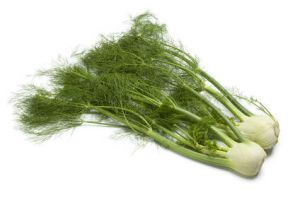
Cooking with fennel is a great way to add flavor and nutrition to many dishes. The bulb looks a bit like a cross between an onion and the base of a celery bunch, and has a firm, crunchy texture with a taste similar to licorice.
When adding it to your meals, rather than making the food taste like licorice, it actually helps to bring out a nice spring-like quality.
This aromatic herb, including the bulb, stalks, leaves and seeds, has been a staple in Mediterranean cuisine for many years; the roots and leaves have been used for medicinal purposes since ancient times.
The Greeks referred to fennel as “marathon,” and passed down a myth through the generations that it was delivered to mortals by the gods at Olympus in a fennel stalk filled with coal. Both Greeks and Romans revered it for its medicinal and culinary properties.
Just some of the health benefits that fennel offers include:
Powerful antioxidants. Fennel contains a unique combination of phytonutrients that help to give it powerful antioxidant activities, including anethole which has been shown to reduce inflammation and prevent cancer. In addition to its phytonutrients, it contains two other powerful antioxidants, vitamins A and C, which help protect the body from free radical damage.
Aiding digestive disorders. Herbs like fennel are considered carminatives, as they are known to contain oils that help to relax the stomach and help to stimulate the digestive system. This, in turn, aids in preventing the formation of gas. Fennel has long been used to relieve bloating, gas discomfort and flatulence, as well as to stimulate the appetite.
High fiber content. Fennel is rich in fiber, which is known to help decrease elevated cholesterol levels as well as to reduce the risk of colon cancer.
Folate and potassium. Fennel is an excellent source of folate, which is essential for transforming harmful homocysteine molecules into benign molecules. High levels of homocysteine are known to cause direct damage to blood vessel walls, contributing to strokes and heart attacks. Fennel also contains potassium, which helps to lower high blood pressure, further lessening stroke and heart attack risk.
How to shop for fennel
Fennel is usually available from autumn through early spring. When shopping for it, always buy organic and look for clean, firm bulbs that don’t have any signs of bruising, spotting or splitting.
They should be white or pale green, while leaves and stalks should be green in color. If there are any signs of flowering buds, don’t purchase them, as this indicates that the fennel is past its time. It should also have a slight licorice or anise aroma.
Cooking with fennel
There are many ways to use fennel, including these ideas:
Make a fennel salad. The Italian version of a fennel salad is delicious. Marinate very thinly sliced, raw fennel in organic, extra-virgin olive oil, lemon juice, salt and pepper. Serve at room temperature.
 Add to mashed potatoes. To liven up mashed potatoes, steam two to three fennel bulbs until tender, then puree them in a food processor with organic olive oil and cream. Combine with cooked mashed potatoes and add a little sea salt to taste.
Add to mashed potatoes. To liven up mashed potatoes, steam two to three fennel bulbs until tender, then puree them in a food processor with organic olive oil and cream. Combine with cooked mashed potatoes and add a little sea salt to taste.
Saute. Saute fennel and onions together for a tasty, nutritious side dish.
Enjoy as an appetizer. Top thinly sliced fennel with plain organic yogurt and mint leaves.
-The Alternative Daily

